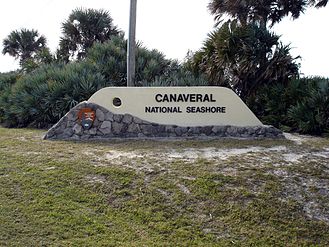Canaveral National Seashore
| Canaveral National Seashore | |
|---|---|
IUCN category V (protected landscape/seascape) | |
 An eastward view of the shoreline at sunrise | |
| Location | Brevard County and Volusia County, Florida, United States |
| Nearest city | New Smyrna Beach, Florida and Titusville, Florida |
| Coordinates | 28°46′03″N 80°46′37″W / 28.76750°N 80.77694°W |
| Area | 57,662 acres (23,335 ha)[1] |
| Established | January 3, 1975 |
| Visitors | 1,005,001 (in 2011)[2] |
| Governing body | National Park Service |
| Website | Canaveral National Seashore |
The Canaveral National Seashore (CANA) is a National Seashore located between New Smyrna Beach and Titusville, Florida, in Volusia and Brevard Counties. The park, located on a barrier island, was created on January 3, 1975, by an act of Congress. Canaveral National Seashore celebrated its 25th birthday on January 3, 2000; however, the concept for the park actually originated 44 years earlier. This 25 miles of pristine Atlantic Ocean beach, dunes and Mosquito Lagoon is the longest expanse of undeveloped land along the East Coast of Florida and as a federally protected area will remain primarily as it is today.
During 1955, a National Park Service (NPS) survey team visited the Turtle Mound area and "found the seashore a priceless scenic and scientific resource for which there is no substitute". Ten years later, T. C. Wilder, president of the New Smyrna Beach (NSB) Chamber of Commerce, organized a Seashore Park subcommittee, acting on a recommendation by the East Central Florida Regional Planning Council (ECFRPC) to follow up on the NPS report. The committee included several former presidents of the NSB Chamber of Commerce. They were Dr. Cook (committee chairman), John Deal, and Walter Mulbury. Other members were Ed Hughes, mayor of NSB, Bill Owens of the ECFRPC, Volusia County Commissioner Harris Saxon, Chamber of Commerce Director William I. Smith, and Chamber of Commerce Manager Hanford Eckman.
Their purpose was "to meet with state and NPS officials, as well as area chambers of commerce to promote the creation of a 15-mile-long National Seashore on the Atlantic Ocean south of New Smyrna Beach. The proposed name was Cape Canaveral National Seashore". Robert G. Howard, ECFRPC director, in a February 2, 1968, letter to the chamber, stated: "The proposal to preserve 9,000 acres of land between Cape Kennedy and New Smyrna Beach is without doubt the Region’s most important recreational project. The entire country today has only 10 national seashores, including Gulf Island National Seashore in the Florida Panhandle and Cape Lookout in North Carolina. No other recreation site in the Region, the State, or perhaps the Nation can compare with it".
On April 26, 1968, the Volusia County Board of Commissioners passed Resolution No. 68-51 requesting the Department of the Interior to establish the National Seashore on the east coast of Volusia County, Florida. In 1968, William V. "Bill" Chappell was elected to the U.S. House of Representatives. During his first year in office, Chappell promised the chamber that the seashore project would be one of his top priorities. He kept his word and on April 5 and 6, 1974, Congressman Roy Taylor, chairman of the house subcommittee on National Parks and Recreation, brought a congressional party to review the proposed site. A second group, including chairman of the Senate National Parks and Recreation Committee, Senator Alan Bible, visited on April 19. By this time, the original 9,000 acres had grown to 35,000. Things then began to progress quickly. The House passed the Seashore Act on December 3, as did the Senate on December 17. After 10 years of perseverance, the chamber realized its goal to establish Canaveral National Seashore when President Gerald Ford signed his approval on January 3, 1975.[3] Local artist and environmentalist Doris Leeper was instrumental in the creation of the park.[4]
The Canaveral National Seashore is home to more than 1,000 plant species and 310 bird species. CANA occupies 57,662 acres (23,335 ha)[1] (including lagoons). The park's 24-mile-long beach is the longest undeveloped beach on the east coast of the state. The southern part is also known as Playalinda Beach, the middle section as Klondike Beach, and the northern section as Apollo Beach.
The John F. Kennedy Space Center is located at the southern end of the barrier island occupied by Canaveral National Seashore, so access to the seashore is often restricted during launch-related activities at the space center. Mosquito Lagoon borders the other side of the cape from the seashore.
The Playalinda Beach has 13 parking lots numbered from the south. The space shuttle launch facility is easily visible from the approach to Parking Lot number one.
-
Entrance to the park
-
A SSE view down the shore
-
A NNW view up the shore
-
Castle Windy Trail in the park
-
Looking north on the southern part of the seashore
See also
References
- ^ a b "Listing of acreage – December 31, 2011" (XLSX). Land Resource Division, National Park Service. Retrieved 2012-12-26. (National Park Service Acreage Reports)
- ^ "NPS Annual Recreation Visits Report". National Park Service. Retrieved 2012-12-26.
- ^ "HISTORY OF CANAVERAL NATIONAL SEASHORE". North Brevard Business Directory. Retrieved April 28, 2015.
- ^ "Doris Leeper". Florida Division of Cultural Affairs. Retrieved May 2, 2012.
External links
 Canaveral National Seashore travel guide from Wikivoyage
Canaveral National Seashore travel guide from Wikivoyage- National Park Service: Canaveral National Seashore
- scheduled closing (e.g. for rocket launches)
- IUCN Category V
- Atlantic Coast barrier islands of Florida
- Protected areas of Brevard County, Florida
- National Seashores of the United States
- Parks in Brevard County, Florida
- Protected areas of Volusia County, Florida
- Protected areas established in 1975
- National Park Service areas in Florida
- Beaches of Brevard County, Florida
- Beaches of Volusia County, Florida
- Beaches of Florida
- Islands of Brevard County, Florida
- Islands of Volusia County, Florida
- Islands of Florida
- 1975 establishments in Florida







